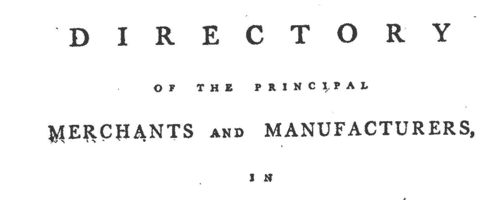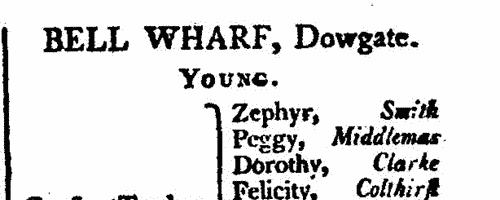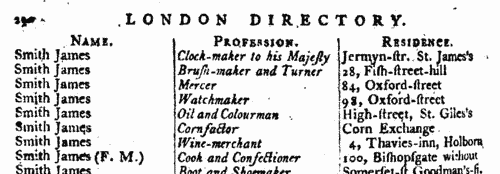Add this eBook to your basket to receive access to all 436 records. Our indexes include entries for the spelling dowson. In the period you have requested, we have the following 436 records (displaying 81 to 90): These sample scans are from the original record. You will get scans of the full pages or articles where the surname you searched for has been found. Your web browser may prevent the sample windows from opening; in this case please change your browser settings to allow pop-up windows from this site.  Masters of Apprentices registered in Norfolk
(1777) Masters of Apprentices registered in Norfolk
(1777)
Apprenticeship indentures and clerks' articles were subject to a 6d or 12d per pound stamp duty: the registers of the payments usually give the master's trade, address, and occupation, and the apprentice's name, as well as details of the date and length of the apprenticeship. There are central registers for collections of the stamp duty in London, as well as returns from collectors in the provinces. These collectors generally received duty just from their own county, but sometimes from further afield. The indentures themselves can date from a year or two earlier than this return. (The sample entry shown on this scan is taken from a Bristol return. Each entry has two scans, the other being the facing page with the details of the indenture, length of service, and payment of duty.) IR 1/60 | Sample scan, click to enlarge

| Subscribers to the Racing Calendar: London and Middlesex
(1777)
The extensive subscription list for 1777 to the annual Racing Calendar first gives the names of the nobility, then the other subscribers county by county for England, with separate sections for Wales, Ireland and Scotland. Initials or christian names are stated only occasionally. | Sample scan, click to enlarge

|  Masters of Apprentices registered in Norfolk
(1778) Masters of Apprentices registered in Norfolk
(1778)
Apprenticeship indentures and clerks' articles were subject to a 6d or 12d per pound stamp duty: the registers of the payments usually give the master's trade, address, and occupation, and the apprentice's name, as well as details of the date and length of the apprenticeship. There are central registers for collections of the stamp duty in London, as well as returns from collectors in the provinces. These collectors generally received duty just from their own county, but sometimes from further afield. The indentures themselves can date from a year or two earlier than this return. (The sample entry shown on this scan is taken from a Bristol return. Each entry has two scans, the other being the facing page with the details of the indenture, length of service, and payment of duty.) IR 1/60 | Sample scan, click to enlarge

| Merchants and Manufacturers in Liverpool
(1787)
William Tunnicliff's 'Topographical Survey of the Counties of Stafford, Chester, and Lancaster' included directories of the principal merchants and manufacturers in each county. For Lancashire, there are lists of traders in Bacup, Blackburn, Bolton, Burnley, Bury, Haslingden, Kirkham, Lancaster, Leigh, Liverpool, Manchester, Prescot, Preston, Rochdale, Rossendale, Ulverston and Wigan.
| Sample scan, click to enlarge

| Masters of Merchantmen at Charleston (1788)
The custom house at Charleston, South Carolina, reported ships entered inwards, cleared outwards and sailed. These give the type of vessel, the name of the vessel, surname of the master, and (for ships arriving) whence they had come, or (for ships departing) their proposed destination. Most of the traffic was with other American ports (over 700 ships a year), Britain (about 150), and the West Indies.
| Sample scan, click to enlarge

| Lawyers, Law Officers and Clerks in London
(1791)
The London Law Directory section of the Universal British Directory includes lists of officers, officials and clerks from the High Court of Chancery, Hanaper Office, Examiners Office, Commissioners of Bankrupts, Corporation of Cursitors Office, Commissioners of Lunatics, the courts of King's Bench, Common Pleas, and Exchequer, the Exchequer Office of Pleas, &c. &c., the Duchy of Lancaster Office, the Lord Mayor's Court Office, and the Court of Marshalsea, as well as public notaries, officers of the judges' circuits, proprietors of provincial newspapers, sworn brokers of the City of London, and Jew brokers. | Sample scan, click to enlarge

| London Bankers and Merchants
(1791)
The British Universal Directory lists the various British trading companies established by statute, starting with the Bank of England, the Million Bank, the East India Company, &c., and including insurance companies. Also included are His Majesty's Consuls Abroad for the Protection of Trade, in European countries, America and Barbary; receivers-general; and the Commissioners of Sewers, Lamps and Pavements for the 28 wards of the City of London. | Sample scan, click to enlarge

| London Wharfingers and Masters of Coastal Shipping
(1791)
A list of the wharfs and wharfingers in London; the places they ship goods for; the vessels in the trade; with the masters' names, where to be spoken with, and time of sailing: from the Universal British Directory | Sample scan, click to enlarge

| Traders and Merchants in London
(1791)
The Universal British Directory was published in five volumes, starting in 1791. The professions included in the London section are very diverse: the addresses are mostly from central London. Some are marked 'F. M.', meaning Freeholder of Middlesex. | Sample scan, click to enlarge

|  Apprentices registered in Norwich
(1793) Apprentices registered in Norwich
(1793)
Apprenticeship indentures and clerks' articles were subject to a 6d or 12d per pound stamp duty: the registers of the payments usually give the master's trade, address, and occupation, and the apprentice's name, as well as details of the date and length of the apprenticeship. There are central registers for collections of the stamp duty in London, as well as returns from collectors in the provinces. These collectors generally received duty just from their own county, but sometimes from further afield. The indentures themselves can date from a year or two earlier than this return. (The sample entry shown on this scan is taken from a Bristol return. Each entry has two scans, the other being the facing page with the details of the indenture, length of service, and payment of duty.) IR 1/67 | Sample scan, click to enlarge

|
Research your ancestry, family history, genealogy and one-name study by direct access to original records and archives indexed by surname.
|












